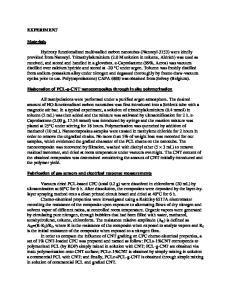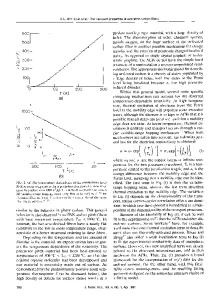Electrical properties of plastic composites using Br 2 -intercalated vapor-grown carbon fibers as a conductive filler
- PDF / 907,587 Bytes
- 5 Pages / 576 x 792 pts Page_size
- 40 Downloads / 321 Views
H. Yamanashi and H. Ushijima Applied Research & Development Office, Yazaki Corporation, Gotemba 412, Japan (Received 3 November 1993; accepted 3 March 1994)
Graphite fiber intercalation compounds were prepared by immersing graphitized thin vapor-grown carbon fibers (VGCF's) with diameters less than 0.5 /xva into liquid bromine. The composition of Br2-intercalated VGCF was C7oBr-C9oBr. The powder resistivity of Br2 -intercalated VGCF was estimated as 1/3 of pristine VGCF. An electroconductive plastic composite was prepared by mixing phenol resin with that of bromine intercalated VGCF as a conductive filler, and its electrical properties were investigated. The resistivity of a Br2-intercalated VGCF composite was 1.1 X 10~2 Cl • cm at room temperature, which is about 50% of pristine VGCF composite. Br2-intercalated VGCF-based composite had a high degree of stability against exposure at 150 °C in air and at 85 °C with 90% humidity for 500 h. Br2-intercalated VGCF-based plastic composites could be used as highly electroconductive materials.
I. INTRODUCTION Carbon-based electroconductive plastic composites are used in electronic applications such as conductors for contact switches, heaters, and antielectrostatic materials. They are lightweight and corrosion resistant conductive materials which are easily molded. Electroconductive carbon black, natural graphite powder, and milled or chopped carbon fibers have been used as carbon fillers. However, these carbon-based composites have not been used in applications where high conductivity is required, such as electromagnetic shielding materials and conducting materials. The commercial grade carbonbased conductive composites have resistivity higher than 10° O • cm. 1 Graphite intercalation compounds (GIC's) are prepared by inserting atomic or molecular layers of guest chemical species between the host graphite layers. GIC's have properties such as high conductivity, superconductivity, and catalytic activity.2'3 GIC's may be used as electroconductive materials4'5; however, the air stability of most GIC's at relatively high temperature or under high humidity is not sufficient for conductive materials. Vapor-grown carbon fibers (VGCF's) are produced by thermal decomposition of gas phase hydrocarbons such as benzene in the presence of an ultrafine iron catalyst.6'7 Recently, it has been reported that thin VGCF's were continuously grown by floating catalyst particles obtained by thermal decomposition of hydroa 'Permanent
address: Gotemba 412, Japan.
Yazaki
Corporation,
252
Kawashimada,
J. Mater. Res., Vol. 9, No. 7, Jul 1994
http://journals.cambridge.org
Downloaded: 15 Mar 2015
carbons; moreover, this method is suitable for mass production of VGCF's. 6 " 8 VGCF's are not continuous like conventional extruded carbon fibers, such as polyacrylonitrile (PAN) or pitch-based carbon fibers. Furthermore, it has been shown that VGCF's have a high degree of electrical conductivity because of their high graphitization.9'10 It was also reported that VGCF-based GIC's have stability an
Data Loading...











